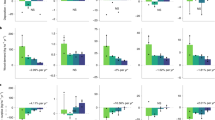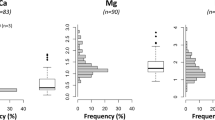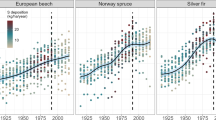Abstract
CALCIUM is the fifth most abundant element in trees, and is an essential component for wood formation and the maintenance of cell walls. Depletion of Ca from the rooting zone can result in acidification of soil1 and surface water2 and possibly growth decline and dieback of red spruce3,4. During the past six decades, concentrations of root-available Ca (exchangeable and acid-extractable forms) in forest-floor soils have decreased in the northeastern United States5,6. Both net forest growth and acid deposition have been put forth as mechanisms that can account for this Ca depletion5,6. Here, however, we present data collected in red spruce forests in the northeastern United States that are inconsistent with either of these mechanisms. We propose that aluminium, mobilized in the mineral soil by acid deposition, is transported into the forest floor in a reactive form that reduces storage of Ca, and thus its availability for root uptake. This results in potential stress to trees and, by increasing the demand for Ca, also decreases neutralization of drainage waters, thereby leading to acidification of lakes and streams.
This is a preview of subscription content, access via your institution
Access options
Subscribe to this journal
Receive 51 print issues and online access
$199.00 per year
only $3.90 per issue
Buy this article
- Purchase on Springer Link
- Instant access to full article PDF
Prices may be subject to local taxes which are calculated during checkout
Similar content being viewed by others
References
van Breemen, N., Mulder, J. & Driscoll, C. T. Pl. Soil 75, 283–308 (1983).
Jenkins, A., Waters, D. & Donald, A. J. Hydrol. 124, 243–261 (1991).
Shortle, W. C. & Smith, K. T. Science 204, 1017–1018 (1988).
McLaughlin, S. B., Tjoelker, M. G. & Roy, W. K. Can. J. For. Res. 23, 380–386 (1992).
Shortle, W. C. & Bondietti, E. A. Wat. Air & Soil Pollut. 61, 253–267 (1992).
Johnson, A. H., Andersen, S. B. & Siccama, T. G. Can. J. For. Res. 24, 39–45 (1994).
Kahl, J. S. et al. Envir. Sci. Technol. 27, 565–568 (1993).
Blume, L. J. et al. Handbook of Methods for Acid Deposition Studies (600/4-90/023, United States Environmental Protection Agency, Washington DC, 1990).
Thomas, G. W. in Methods of Soil Analysis Part 2 (eds Miller, R. H. & Keeney, D. R.) 161–164 (Soil Sci. Soc. of America, Madison, Wisconsin, 1982).
Friedland, A. J., Johnson, A. H. & Siccana, T. G. Wat. Air & Soil Pollut. 21, 161–170 (1984).
Parry, S. J. in Chemical Analysis (eds Wineforder, J. D. & Kolthoff, I. M.) Vol. 19 (Wiley, New York, 1991).
Federer, C. A., Turcotte, D. E. & Smith, C. T. Can. J. For. Res. 23, 1026–1032 (1993).
Lawrence, G. B., Shortle, W. C., David, M. B., Wargo, P. M. & Vogt, K. Study Plan for the Global Change Research Program (US Forest Service Northern Global Change Program Internal Rep., Radnor, Pennsylvania, 1992).
Lawrence, G. B., Lincoln, T. A., Horan-Ross, D. A., Olson, M. L. & Waldron, L. A. Open-File Rep. 95-416 (US Geol. Surv., Troy, New York, 1995).
Cronan, C. S., Walker, W. J. & Bloom, P. R. Nature 324, 140–143 (1986).
Mulder, J. & Stein, A. Geochim. cosmochim. Acta 58, 85–94 (1994).
Johnson, D. W. & Fernandez, I. J. in Ecology and Decline of Red Spruce in the Eastern United States (eds Eager, C. & Adams, M. B.) 235–270 (Springer, New York, 1992).
NADP/NTN Annual Data Summary 1992 (Nat. Atmospheric Deposition Progm, Colorado State Univ., Fort Collins, Colorado, 1993).
DeConinck, F. Geoderma 24, 101–128 (1980).
van Breemen, N., Driscoll, C. T. & Mulder, J. Nature 307, 599–604 (1984).
Cronan, C. S. & Goldstein, R. A. in Acidic Precipitation Vol. 1: Case Studies (eds Adriano, D. C. & Havas, M.) 113–135 (Springer, 1989).
Rustad, L. E. & Cronan, C. S. Biogeochemistry 29, 107–129 (1995).
Mulder, J., Pijpers, M. & Christophersen, N. Wat. Resour. Res. 27, 2919–2928 (1991).
Rustad, L. E. thesis, Univ. Maine, (1988).
Cronan, C. S. Tree Physiol. 8, 227–237 (1991).
Federer, C. A. BROOK90 Version 3.0 (Freeware Computer Program & Documentation, US Forest Service, Durham, NH, 1994).
Miller, E. K., Blum, J. D. & Friedland, A. J. Nature 362, 438–441 (1993).
Hedin, L. O. et al. Nature 367, 351–354 (1994).
Author information
Authors and Affiliations
Rights and permissions
About this article
Cite this article
Lawrence, G., David, M. & Shortle, W. A new mechanism for calcium loss in forest-floor soils. Nature 378, 162–165 (1995). https://doi.org/10.1038/378162a0
Received:
Accepted:
Issue Date:
DOI: https://doi.org/10.1038/378162a0
This article is cited by
-
Surprising relationships between soil pH and microbial biomass and activity in a northern hardwood forest
Biogeochemistry (2023)
-
Effects of oyster shell powder on leaching characteristics of nutrients in low-fertility latosol in South China
Environmental Science and Pollution Research (2022)
-
Responses to soil pH gradients of inorganic phosphate solubilizing bacteria community
Scientific Reports (2019)
-
Plant richness and composition in hardwood forest understories vary along an acidic deposition and soil-chemical gradient in the northeastern United States
Plant and Soil (2019)
-
Soil Base Saturation Combines with Beech Bark Disease to Influence Composition and Structure of Sugar Maple-Beech Forests in an Acid Rain-Impacted Region
Ecosystems (2018)
Comments
By submitting a comment you agree to abide by our Terms and Community Guidelines. If you find something abusive or that does not comply with our terms or guidelines please flag it as inappropriate.



